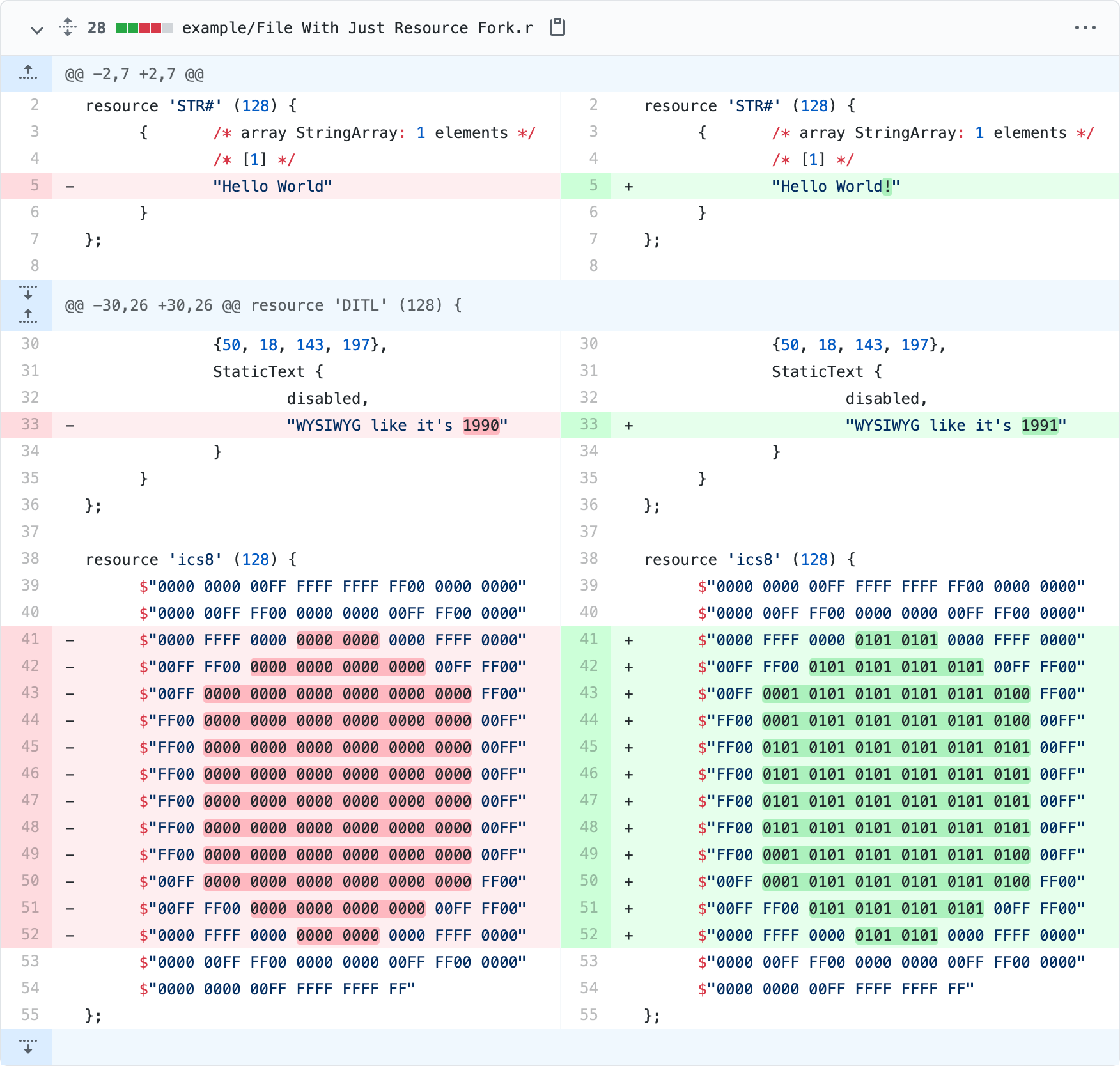Making Git Understand Classic Mac Resource Forks #
For a (still in-progress) digital archiving project I wanted to create a Git repository with some classic Mac OS era software. Such software relies on resource forks, which sadly Git does not support. I looked around to see if others had run into this, and found git-resource-fork-hooks, which is a collection of pre-commit and post-checkout Git hooks that convert resource forks into AppleDouble files, allowing them to be tracked. However, there are two limitations of this approach:
- The tools that those hooks use (
SplitForksandFixupResourceForks) do not work on APFS volumes, only HFS+ ones. - The resource fork file is generated is an opaque binary blob. While it can be stored in a Git repository, it does not lend itself to diffing, which would ruin the “time machine” aspect of the archiving project.
I remembered that there was a textual format for resource forks (.r files) which could be “compiled” with the Rez tool (and resource forks could be turned back into .r files with its DeRez companion). This MacTech article from 1998 has more details on Rez, and even mentions source control as a reason to use it.
I searched for any Git hooks that used Rez and found git-xattr-hooks, which is a more specialized subset that only looks at icns resources (incidentally a resource I am very familiar with). That seemed like a good starting point, it was mostly a matter of removing the -only flag.
The other benefit of Rez is that it can be given resource definitions in header files, so that it produces even more structured output. Xcode still ships with resource definitions, and they make a big difference. Here’s the output for a DITL (dialog) resource without resource definitions:
$ DeRez file.rsrc
data 'DITL' (128) {
$"0003 0000 0000 0099 002F 00AD 0069 0405" /* .......?./.?.i.. */
$"4865 6C6C 6F00 0000 0000 0099 007F 00AD" /* Hello......?...? */
$"00B9 0405 576F 726C 6400 0000 0000 000C" /* .?..World....... */
$"0056 002C 0076 A002 0080 0000 0000 0032" /* .V.,.v?..?.....2 */
$"0012 008F 00C5 8816 5759 5349 5759 4720" /* ...?.ň.WYSIWYG */
$"6C69 6B65 2069 7427 7320 3139 3931" /* like it's 1991 */
};
And here it is with the system resource definitions (the combination of parameters that works was found via this commit):
$ DeRez -isysroot `xcrun --sdk macosx --show-sdk-path` file.rsrc Carbon.r
resource 'DITL' (128) {
{ /* array DITLarray: 4 elements */
/* [1] */
{153, 47, 173, 105},
Button {
enabled,
"Hello"
},
/* [2] */
{153, 127, 173, 185},
Button {
enabled,
"World"
},
/* [3] */
{12, 86, 44, 118},
Icon {
disabled,
128
},
/* [4] */
{50, 18, 143, 197},
StaticText {
disabled,
"WYSIWYG like it's 1991"
}
}
};
Putting all of this together I have created git-resource-fork-hooks, a collection of Python scripts that can be used as pre-commit and post-checkout hooks. They end up creating parallel .r files for each file that has a resource fork, and combining it back on-disk. I briefly looked to see if I could use clean and smudge filters to implement this in a more transparent way, but those are only passed in the file contents (the data fork), and thus can't read or write to the resource fork.
The repo also includes a couple of sample files with resource forks, and as you can see, the diffs are quite nice, even for graphical resources like icons:

I’m guessing that the number of people who would find this tool useful is near zero. On the other hand, Apple keeps shipping the Rez and DeRez tools (and even provided native ARM binaries in Big Sur), thus implying that there is still some value in them, more than two decades after they stopped being a part of Mac development.
An elegant [format], for a more... civilized age.
All of this thinking of resource forks made me a bit nostalgic. It’s pretty incredible to think of what Bruce Horn was able to do with 3K of assembly in 1982. Meanwhile some structured formats that we have today can be so primitive as to not allow Norway or comments. I have a lot of fond memories of using ResEdit to peek around almost every app on my Mac (and cheat by modifying saved tank configs in SpectreVR).
Once I started to develop for the Mac, I appreciated even more things:
- Being able to use
TMPLresources to define your own resource types and then have them be graphically editable. - How resources played nicely with the classic Mac OS memory management system - resources were loaded as handles, and thus those that were marked as “purgeable” could be automatically unloaded under memory pressure.
- Opened resource forks were “chained” which allowed natural overriding of built-in resources (e.g. the standard info/warning/error icons).
While “Show Package Contents” on modern macOS .app bundles has some of the same feel, there’s a lot more fragmentation, and of course there’s nothing like it on iOS without jailbreaking, which is a much higher barrier to entry.
1 Comment
Post a Comment